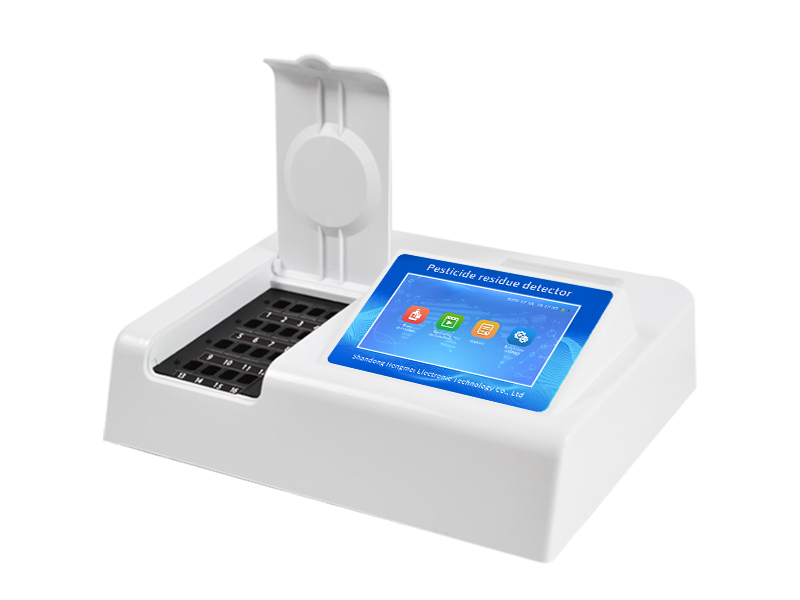In today's world where food safety is increasingly receiving global attention, the issue of pesticide residues in fruits and vegetables has become a significant public health hazard. With the advancement of technology and the innovation of detection techniques, pesticide residue detectors are becoming a "technological shield" to ensure food safety with their high efficiency and accuracy. From the fields to the dining table, this device not only provides consumers with transparent quality assurance, but also promotes the intelligent upgrading of the agricultural industry chain.

Technological Innovation: Scientific Principles of Precise Detection
The core principle of the fruit and vegetable pesticide residue detector is based on enzyme inhibition rate method and photoelectric colorimetric method. Organophosphorus and carbamate pesticides can inhibit the activity of cholinesterase. By detecting the positive correlation between this inhibition rate and pesticide concentration, the instrument can quickly screen the sample within minutes. For example, during detection, the instrument illuminates the reaction solution with a specific wavelength (such as 410nm) light source, captures changes in absorbance using high-precision sensors, calculates the inhibition rate, and automatically determines the results. If the inhibition rate is ≥ 50%, it is judged as positive and requires further retesting or laboratory confirmation.
The advantages of this technology lie in its high sensitivity (able to detect up to 0.01ppm dichlorvos), easy operation (no need for constant temperature cultivation), and wide applicability (covering vegetables, fruits, tea, etc.). In addition, modern detectors also incorporate intelligent design, such as built-in databases of hundreds of vegetables, support for custom name management, and real-time data sharing and traceability through wireless uploading, cloud storage, and other functions.
Product advantage: The perfect combination of efficiency, convenience, and precision
The pesticide residue detectors currently on the market have achieved multi-channel synchronous detection (6-24 channels), supporting batch processing of samples and significantly improving detection efficiency. For example, a 12 channel device can independently run multiple sample tests on the same interface to avoid mutual interference; The portable model is equipped with a large capacity lithium battery and a car power interface to meet the needs of outdoor mobile detection.

In terms of technical parameters, mainstream equipment has the following characteristics:
High precision optical system: using solid-state cold light source and imported light-emitting diodes to avoid environmental light interference, with a transmittance accuracy of ± 1.5%;
Intelligent operation: 7-10 inch LCD touch screen, Chinese menu guidance, automatic calibration function, non professionals can operate with simple training;
Data Management Upgrade: Supports storage of 200000 pieces of data, Excel format export, GPRS wireless transmission to meet regulatory and traceability needs.
Application scenario: Full chain coverage from production to consumption
Agricultural production end: Fruit and vegetable planting bases can use detectors for self inspection, optimize pesticide use strategies, and achieve green production.
Circulation link: Agricultural wholesale markets and supermarket distribution centers intercept products that exceed the standard through batch inspections, building a safety line from the field to the shelves.
Terminal consumption scenario: School canteens and catering enterprises use portable devices to dynamically monitor ingredients, ensuring that every vegetable served on the table is safe and controllable.
Taking a university cafeteria as an example, after introducing an intelligent detection system, abnormal pesticide residues were found in a batch of green leafy vegetables through big data analysis. The traceability mechanism was promptly activated to successfully prevent problematic ingredients from flowing into the dining table. This case highlights the value of the detector in risk warning and emergency response.

The pesticide residue detector for fruits and vegetables is not only a technological tool for food safety supervision, but also an important tool for promoting sustainable agricultural development. Through precise detection capabilities and intelligent management solutions, it is reshaping the entire chain trust system from production to consumption. For enterprises, choosing a stable and fully functional detector can not only enhance brand credibility, but also protect consumers' "tongue safety" with the power of technology, injecting lasting momentum into the high-quality development of the industry.
Address of this article:http://www.hmfoodtesting.com/article/29.html


 Current
location:
Current
location:





